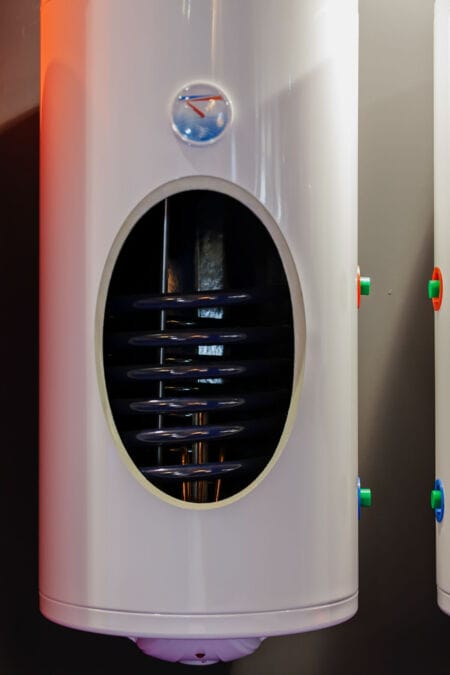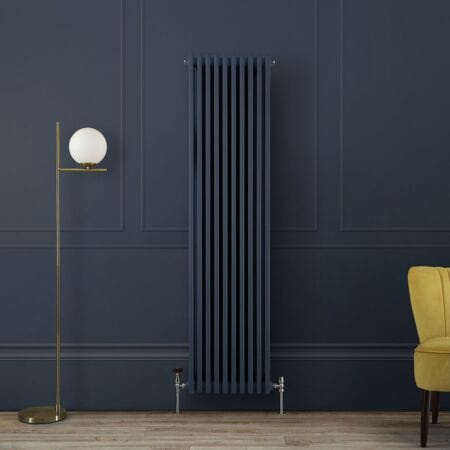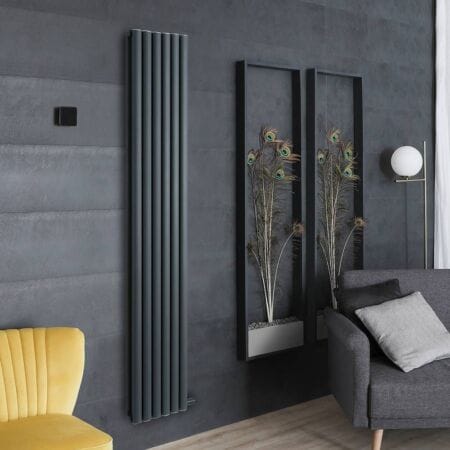Contents
ToggleWhat we’ll cover…
- A variety of reasons why drying clothes on radiators is not typically recommended
- The possibility of increased energy costs and higher utility bills stemming from from the boiler being forced to work harder
- Moisture accumulation causing condensation, potential mould growth, and risks to health
- The detrimental effect clothes on radiators can have on heating efficiency
- Potential fire hazards from leaving unattended clothes on hot radiators
- Safer alternative options for indoor drying of clothes
- The usage of drying racks or clothes horses situated close to radiators
- Opening windows and making use of extractor fans for enhanced ventilation
- Outsorcing to launderettes for bigger drying requirements
- Utilising heated towel rails as a bathroom option as opposed to main radiators
- A brief history and notes on the evolution of radiator designs from primitive heating methods to modern solutions
Is drying clothes on a radiator a good idea?
Imagine if you will…
It’s the weekend, the weather is at best ‘changeable’ (this is the UK after all), and yet there’s a pile of washing that needs to be done for Monday morning that would give Kilimanjaro a run for its mountainous money.
You don’t own a tumble dryer and half of the stuff you need to get clean for the coming week has the dreaded circle with a cross through it – “not to be placed in a tumble dryer” – symbol on the label anyway.
It’s too cold to get anything dry outside on the washing line and lighting a fire in your garden to counteract the cold (and dry your clothes) is a hell of a lot of hard work – not to mention the smell of fire not really going down too well in the office, classroom or portakabin – so what do you do?
Chances are you’ll take the step of using a clothes maiden or maybe even go a little further and lay your clothes out over the top of your radiators – but guess what? – you probably shouldn’t!
Can drying clothes on a radiator be unhealthy?
Though drying your clothes on a radiator may seem innocent enough, experts in Manchester have issued a stark health warning against doing so.
Scientific boffins at the National Aspergillosis Centre in Manchester have asked that we think twice before overloading our hot-boxes with clothes, after treating a growing number of people who had inhaled (incredibly dangerous) Aspergillus fungal spores.
Most of us won’t be unduly affected by these spores, as we’re either immune to the fungus or we have sufficiently healthy immune systems that will help us to fight off any infection.
But if you are an asthma sufferer, a cancer patient, or someone with a weak or damaged immune system, the fungus can cause pulmonary aspergillosis – a condition that, if left unchecked, can cause irreparable, and often fatal, damage to the lungs and sinuses.
So drying your clothes on radiators could potentially be a life-threatening thing to do – but is there a way around it that helps you to minimise the risk?
What is Aspergillosis?
Normally affecting the respiratory system (lungs, windpipe & sinuses), Aspergillosis is the name given to a group of conditions that are caused by a fungal mould called aspergillus.
The level of severity of the condition depends upon a number of different factors and can range from mild wheezing to coughing up blood and, in extreme cases, even death.
Can I reduce my risk of exposure?
As I said above, sometimes there can be (very) little option but to put clothes on the radiator to dry, but, before I completely scare you into going out and buying a tumble dryer or frighten you into digging a pit fire, there are a couple of things you can do to protect yourself.
Now, you won’t have to do this if it’s just the odd pair of socks or underpants that you’ve hung over your radiator (though it won’t hurt), but if you must dry your washing inside, you really should have a window open to help keep the space well ventilated.
Another option is to invest in an extractor fan or dehumidifier to actively reduce moisture levels in the drying area.
Good Housekeeping’s Consumer Director, Caroline Bloor, suggests doing the same – in this article – if you have no option but to dry your clothes inside.
She says that it’s important to “have a window ajar when possible, especially if you are using your bedroom radiator to dry clothing”, adding that “damp clothes should not be dried on storage or convector heaters because this can be a fire hazard.”
So the best way to prevent any kind of reaction or attack is to ensure – on the odd occasion that you do need to dry clothes inside – you have your windows open, avoid drying clothes in living areas and keep wet clothes out of your bedroom – it’s better to be safe than sorry.
Can drying clothes indoors push up my energy bills?
As we’ve already seen, sometimes there is no other option but to dry clothes on or next to a radiator, but as well as the risks to our health when we do this, is there a danger that we could be pushing up our energy prices too?
The simple answer is – YES!
Using your radiators or a towel rail to dry clothes will make your boiler work harder than it really needs to, adding to the overall running costs of the system.
The clothes you place over the top of the radiator prevent the heat from escaping and heating your room, so your boiler has to pick up the slack, using more energy – and costing you more money – to warm your living space.
The extra moisture in the air also means that it takes more energy to heat the whole room (again increasing the costs) and – as well as the health issues I’ve already discussed – it can create a lot of condensation, leading to damp and mould issues that can be very expensive to eradicate.
There was a time when more homes up and down the country had large fires and even larger fireplaces and, due to the laws of physics, these would help to suck away moisture, reduce condensation and keep homes a little drier.
The increase of condensation on walls is largely the result of the improvements that have been made in double-glazing, insulation and the draught-proofing of properties.
These improvements are obviously great for retaining heat and keeping your home nice and cosy, but they can also result in a lack of air ventilation, an increase in stale air and a higher percentage of moisture becoming trapped indoors – none of which are any good for your health and well-being.
How bad can drying clothes on a radiator really be?
If you routinely place clothes on your radiators, you may find that there are certain areas of your home – on walls or behind furniture – that become damp with condensation.
If this is the case in your home, then you have a problem and it may be a good idea to look at ways to reduce the amount of condensation that is being created.
As we’ve already covered, this mould and damp is a big issue for the health of people in your home, but it’s equally as big of an issue for the health and structural integrity of your property.
It may just begin with a few black marks of mould on the wall, but it can soon escalate to bigger and more expensive problems, causing plaster, fixings and even the walls themselves to begin rotting away.
Your wallpaper is likely to blister and begin to peel off and before you know it there’s been some real damage done and you have a full-blown redecorating job on your hands.
Costs can soon begin to escalate
Don’t panic if you do come across an area of condensation or mould. If it is just a small area that has been affected then you may just be able to wipe it away and maybe touch up the area with a little paint or sealant.
If you find that the plaster has been damaged then the costs will begin to rise and, if you can’t turn your hand to a bit of plastering, calling in a professional to complete the job could cost you around £150.
Chances are you’ll be capable of fixing any minor aesthetic ailments yourself, however, if you do need to call upon the services of a handyman or decorator to carry the work out for you, you can expect to pay no less than £70, as very few of them will be happy to book for less than half a day’s work.
If left unchecked, extreme cases of condensation and mould damage can contribute to a dry rot problem that can cause untold structural damage – a scenario that could lead to an extremely expensive repair bill.
How can I prevent mould building up in my home?
It isn’t just placing clothes on your radiators that can contribute to the build-up of mould and condensation in your home; there are a few other factors to bear in mind and a couple of other steps you can take to minimise the impact of damp in your property.
The best way of combatting condensation is to provide proper ventilation throughout your home.
Without a continuous flow of fresh air in and out of your property, the relative humidity inside your home will rise, quickly filling the internal atmosphere with moisture.
This is particularly true in the colder months when you are less likely to be drying clothes outside. As the temperature fluctuates throughout winter, this cycle of cold and slightly colder can contribute to water droplets forming on colder surfaces, leading to mould growth and the more serious issues discussed above.
This problem is more likely to occur on external walls – that is walls that have their other side on the outside of the house.
Of course, you could invest in a dehumidifier to help improve the air quality in your home, but you won’t want to have one running all of the time, so I’ve put together a little list of things you can do to prevent condensation build-up.
Some of them may seem a little tedious, but to borrow a tagline from one of the big brand supermarkets: “Every Little Helps!”
How to reduce condensation in your property
- One single load of everyday washing contains around two litres of water. Be sure that both your washing machine and/or your tumble dryer are properly vented when you use them.
- When it’s possible to do so (on a day without rain), try and dry your washing outside. If you must dry it inside, don’t cover your radiators with clothes and always ensure that windows and doors remain open in order to keep the space ventilated.
- When you’re cooking, simply boiling the kettle or taking a bath or a shower, keep the kitchen and bathroom doors closed. This will prevent steam from entering colder rooms and forming condensation.
- Be sure to cover pans with a lid to reduce moisture when cooking. If you have an extractor fan, use it and don’t switch it off right after you’ve finished cooking, leave it for around quarter-of-an-hour after to ensure you clear the air.
- Be sure to use the extractor fan in your bathroom when taking a bath or a shower. Don’t you have one? Get one installed, it will help to reduce your risk of mould build-up and prolong the life of your bathroom walls.
- Plants and pets produce water too. If you have a fish tank, cover it up and if you’re suffering from excess condensation try moving a few houseplants outdoors and see if that makes any difference.
- If your kitchen or bathroom has no extractor fan, be sure to wipe down surfaces when you’ve finished cooking or showering. The excess moisture that hangs around on surfaces can very quickly turn into something nastier than a bit of water and is even more difficult to get rid of.
- Try not to overfill wardrobes or kitchen cupboards. Trapped air and a lack of ventilation is a breeding ground for mould and spores, so even in here, try to have air circulate as freely as possible.
- Check your level of insulation. Double glazing, loft insulation and draft-proofing will help you to reduce the amount of heat that your property loses. This rise in temperature will help to keep indoor surfaces warmer, but as I mentioned above, be careful not to make the air too stale. Ventilate where you can!
- Try not to breathe! Only joking. But if you do spend a lot of time in one room of your home, try opening a window in there for a while. Breathing is a major player in the condensation game, so ventilating the space will go a long way to improving the quality of the air.
So there you have it.
Looking back, this whole blog has been about ventilation. If you must put clothes on (or near) the radiator to dry – and let’s face it, sometimes there really is no alternative – be sure to provide adequate ventilation to that space.
Open a window.
Install an extractor fan.
Just do what you can to minimise the build-up of moisture in your home, your health will thank you and you’re sure to save on unwelcome renovations in the future.
Stay Safe & Happy Heating!
Frequently Asked Questions
Simply put, drying clothes on a radiator can lead to increased bills over time. Essentially, the use of radiators or heated towel rails to dry clothes will force your boiler to work harder than it would otherwise need to, in turn causing running costs to increase.
There are also health risks attached to drying clothes on a radiator, plus concerns about potential damage it could cause to the surface of your heating device, therefore it is not recommended to dry clothes on a radiator.
To find out more details, take a look at our blog, Should I dry my clothes on a radiator?
There are health warnings against drying clothes on a radiator, with links to the inhalation of dangerous Aspergillus fungal spores.
Although several people may not be adversely affected by these spores, having built up a healthy immune system or growing immunity to the fungus, there are concerns to many others. Those suffering from asthma, cancer patients, and anyone with a damaged or weak immune system can experience significant damage to the sinuses and lungs.
For a more detailed insight, explore our article, Should I dry my clothes on a radiator?
It is not a good idea to dry clothes on a radiator. One of the most obvious adverse effects is that the moisture from wet clothes can seep into the radiator material, potentially leading to rusting and corrosion.
There are other reasons to avoid drying clothes on a radiator where possible, as detailed thoroughly in our article, Should I dry my clothes on a radiator?

John Lawless is SEO Manager at BestHeating and a recognised expert in home heating. With over a decade of experience in the industry, he blends technical insight with practical advice on everything from energy efficiency to radiator design, and more. John’s work has featured in national media and leading home & garden publications, and he leads the editorial strategy for the BestHeating Advice Centre – helping homeowners make smarter heating choices with confidence.




